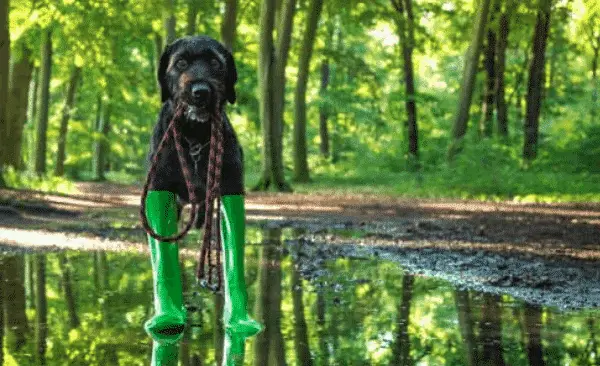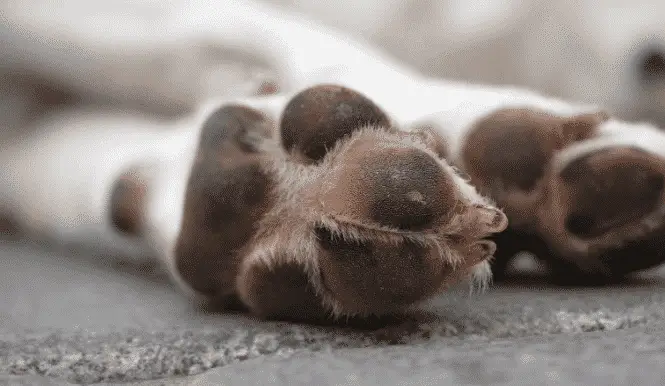Hitting the trails with your dog is a great way to bond while exploring a little slice of nature. That little bit of exploration gives their nose and brain a much need workout from otherwise boring lives.
Ever go on a 15+ mile hike through rough terrain? By the end of the day, I’m drenched in sweat, covered in dirt and usually have a few new holes in my clothes. I’m sore, tired and look like a well-groomed homeless man.
My dog Zoey, on the other hand, looks like she could keep going for days on end. At 2 years old she has an endless amount of energy, but that doesn’t mean she isn’t sore.
A dog’s feet can really take a beating when hiking through gravel and rocky terrain. With one foul step, you can end up with a bloody paw and a limping pooch. Before you take your dog on a long hike you should really think about how you’re going to protect your dogs paws.
Table Of Contents
How to Protect a Dogs Paws on a Hike
Do you think runners just hop off the couch one day and sign up for a marathon? No they definitely don’t! It takes months if not years of training to build up enough endurance for a 26.2 mile run.
Unfortunately, most dogs are fat and lazy just like their owners. You can’t just expect a dog to be ready for a long hike without slowly building up their endurance first.
1) Apply Paw Moisturizers
Check the pads on your dogs paws before heading out. Unless you regularly apply moisturizer your dogs paws probably look dry and cracked. That’s a surefire recipe for bloody, torn up paws after a long hike.
Start applying paw moisturizer to your dogs paws so they can start to heal. Musher’s Secret Paw Wax is an absolute miracle worker! Apply it to your dogs paws 2-3 times per week for about a month and then as needed before hikes.
Paw pad creams are great for dealing with extreme heat and cold, but it’s not a miracle worker. Some surfaces just aren’t good for hiking with dogs. If you plan on hiking through jagged rocks and rough scrambles just leave your best friend at home.
Can I Use Vaseline on My Dogs Paws?
Whether or not it’s a good idea to use vaseline on a dogs paws is up for debate. Vaseline will definitely help prevent rubbing and further injury on a torn pad, but it needs to be wrapped up.
When your dog inevitably licks off the vaseline it’s going to make them sick. Do you really want to deal with diarrhea and vomit in the back of your car?
You’re much better off using a dedicated paw wax (like this) or pet-friendly antibiotic ointment. If you carry a first aid kit for your dog there’s probably ointment already included in the pack.
2) Toughen Up Your Dogs Paws
Your dog needs to toughen up the pads on their paws before they can hit the trail for hours on end. If you don’t start off slow your dog will end up with sore and possibly ripped pads.
Do you really want to carry your dog for miles because of torn up paws? We do everything we can to protect our dogs and sometimes that means carrying a 50lb dog the last 2 hours of a hike. That’s definitely not fun, but your dog would do the same for you if they could.
Try to go on at least 1-2 short hikes per week to really start to build up your dogs hiking endurance. Their muscles will quickly adapt and paws will slowly toughen up. After a month or two of short 1-2hr hikes you’re probably ready for something longer.
3) Keep Nails Short
You’ve probably heard that dogs that walk on concrete don’t need their nails trimmed, but that’s a load of bull crap. If a dog’s nails are long enough to touch the concrete sidewalk they’re far too long. They will wear down slightly on, but not enough to make much of a difference.
You should be getting your dogs nails trimmed every 1-2 months. Just buy a pair of cheap nail clippers or head down to your local groomer for a $10 trim. It’s so much easier to just pay for a nail trimming. Going into work with velociraptor sized scratches all down your arm isn’t a good look.
4) Protect The Dewclaw
Watch out for torn and ripped up dew claws on long hikes. You never know when a dewclaw is going to get caught and ripped off, but boy does it bleed. They’re barely attached and really painful when they get torn off.
Although the injury isn’t serious you will need to apply basic treatment. Carefully rub on a topical antibiotic and wrap the injured dewclaw to prevent further injury. Within about a week the injury should be fully healed.
5) Buy Your Dog Hiking Boots

It’s definitely a good idea to get your dog used to wearing dog boots at a young age. Dog boots can really help protect your dogs paws on rough terrain. They might take some getting used to, but they’re so worth it.
Dog boots will protect your dog’s paws from sharp rocks and extreme heat and cold surfaces. If you plan on doing a lot of winter hiking dog boots are an absolute must. Salt and other chemical treatments used to prevent ice will wreak havoc on a dog’s paws. They end up with blisters, cuts and bloody paws.
Not only do they protect your dogs paws, they also prevent slipping on wet surfaces. I really like Ruffwear’s Lineup of dog boots. They basically last forever and have a really nice grippy tread. Definitely spend the extra money on the Ruffwear boot liners, which add a little extra protection and keep the boots from slipping off.
Do Dogs Really Need Hiking Shoes?
On most hikes a dog’s paws will be perfectly fine without boots. Their paws are built to endure extreme conditions in a wide range of environments. So it’s really hard to say whether or not your dog actually needs hiking shoes.
Hiking shoes are always a good idea, but it depends on the dog. Do you live in a plush apartment and rarely hit the trail? You will definitely need to toughen up your dogs paws and should probably consider buying hiking boots. A dog that spends 99% of the day indoors will have softer paw pads.
If you think that your dog could probably benefit from additional paw protection pick up a pair of boots. Try them out for a couple of weeks and see if your dog will even wear them.
Use treats and distractions to slowly introduce them to the boots. Some dogs just never seem to get used to wearing hiking boots.
6) Check Your Dogs Paws During and After The Hike
You should really be checking your dog’s paws throughout the entire hike. Whenever you stop for a quick break take 30 seconds to look over your dog’s paws.
Apply a little bit of moisturizer to the pads, check between the toes and look at the nails/dewclaws. Probably 99% of the time they will look great, but there could be a pebble or thorn jammed up between the toes.
It never hurts to check, plus they quickly get used to you checking their feet. If there ever ends up being a problem it will be way easier to deal with.
7) Treat Paw Injuries Before They Get Serious
The occasional tore up paw pad is just a part of hiking with your dog. You could have done everything right and the pads still get torn up.
Don’t worry! Dealing with a torn up pad isn’t all that difficult. Hopefully you purchased a good canine first aid kit. Just clean up the wound, apply a dab of antibiotic ointment and wrap the paw in a bandage. Watch the video below for a quick veterinarian demonstration.
Wrapping up the pad just offers a little extra padding for the remainder of the hike. Hopefully you can make it back to the car without causing further injury. Sometimes you might need to carry a dog that back that refuses to walk.




